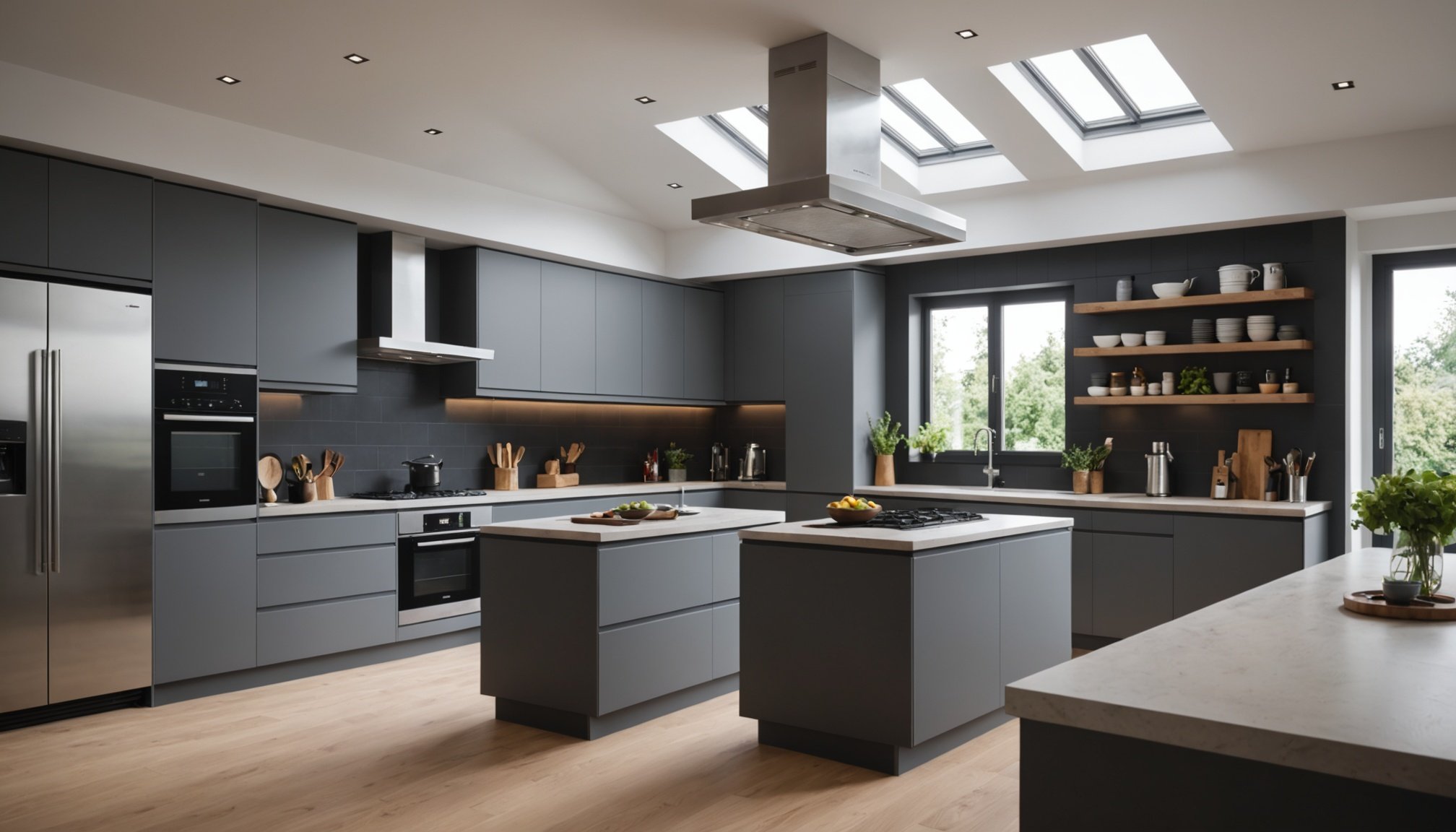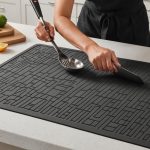Understanding Kitchen Ventilation Systems
Proper kitchen ventilation is essential in maintaining a clean and safe cooking environment. Kitchen ventilation systems function through a combination of extraction, circulation, and filtration. These systems effectively eliminate smoke, odours, and excess heat.
A typical kitchen ventilation system comprises several components such as hoods, ducts, fans, and filters. The hood captures cooking emissions, while ducts guide these pollutants outside. Fans drive this process, and filters trap grease and particulates, ensuring only clean air is returned to the kitchen. These components work together to improve air quality and reduce maintenance needs.
This might interest you : Quick recipes and flavors: fast meals for every palate
For residential use, there are various types of kitchen ventilation systems to consider:
- Ducted systems: These systems discharge air outside the house, offering efficient removal of cooking by-products.
- Ductless systems: Using recirculating fans and carbon filters, these systems are easier to install where exterior venting is not possible. They do, however, require regular maintenance of filters.
- Downdraft systems: Positioned beside or behind cooktops, these capture contaminants at source and are suitable for open-plan spaces.
Understanding the importance of a good ventilation system will support you in choosing the right system, enhancing safety and comfort in your kitchen.
In parallel : Maximize your savings: the ultimate guide to snagging the best uk kitchen gadgets in seasonal sales
Choosing the Right Kitchen Ventilation System
When selecting ventilation systems for a kitchen, several factors need careful consideration. First, evaluate the kitchen size and layout as these dictate the capacity required from a ventilation system. Larger spaces may necessitate more powerful solutions. Equally important is the type of cooking you’ll be doing; frequent frying, for example, might demand a system with higher extraction rates.
For UK homes, some recommended brands include Elica, Bosch, and Neff. These brands offer a range of products designed to suit different needs and styles. Elica, for instance, is known for its innovative designs and high performance, whereas Bosch provides reliable, energy-efficient systems. Neff offers user-friendly interfaces, enhancing the cooking experience.
When evaluating different types of ventilation systems, consider both wall-mounted chimneys and island hoods. Wall-mounted options are space-saving, often blending seamlessly with kitchen cabinetry, while island hoods are ideal for cooktops positioned centrally, making them more visually intrusive but efficient for certain kitchen layouts.
Each system type and brand comes with its own set of advantages and potential drawbacks. Wall-mounted systems, while sleek, might lack the coverage needed for central cooking areas. On the other hand, island hoods, though powerful, require more space and can be more complex to install. Selecting the right system involves balancing these pros and cons against your kitchen’s unique needs.
Installing Your Kitchen Ventilation System
Installing a kitchen ventilation system can enhance air quality and reduce cooking odours. Here’s how to get started.
Preparation for Installation
Before beginning, assess your kitchen layout. Optimal placement is crucial for effective ventilation. Consider the proximity to cooking surfaces and available space for ductwork. This ensures maximum efficiency and minimal disruption. Planning ahead will save time and mistakes during installation.
Step-by-Step Installation Process
Begin by marking the mounting location on the wall. This should align with the ventilation system’s specifications. Drill holes as per the manufacturer’s installation guide, ensuring stability and support. Secure the main unit using appropriate fasteners. Next, connect the ductwork. Check for any leaks to maintain airflow integrity. Lastly, attach filters and complete the electrical setup, adhering strictly to safety standards.
Common Tools and Materials Needed
A successful installation requires a set of specialised tools and materials. Typically, these include a drill, screwdriver, measuring tape, and a spirit level. Ventilation units often come with specific mounts or brackets. Duct tape and sealant may be needed to ensure airtight connections. Having all materials ready before starting simplifies the process, allowing for smoother progress and fewer interruptions.
UK Regulations and Standards
In the UK, regulations regarding kitchen ventilation are outlined to ensure safety and compliance. Adhering to these guidelines is crucial not only for lawful installations but also to maintain a safe and healthy environment. One of the primary regulations concerns installing exhaust systems to effectively remove excess moisture, odours, and combustion products from cooking.
UK rules require kitchen ventilation systems to comply with specific safety standards. These standards ensure that both new constructions and existing kitchens meet fundamental health requirements. This includes the adequate removal of pollutants and maintaining indoor air quality. Compliance with such standards protects occupants from potential health hazards posed by improper ventilation.
During installation, it’s important to adhere strictly to these regulations. Not following them can lead to legal issues, fines, or the necessity of costly adjustments. Additionally, compliance assures the ventilation system’s efficiency and reliability, providing peace of mind to homeowners.
Consult professionals who are well-versed in UK regulations and safety standards for kitchen ventilation when planning or executing installations. This will assist in navigating the complexities of compliance while ensuring that installations meet all necessary requirements. Adhering to these standards is a proactive step towards securing a healthy living space.
Maintenance and Troubleshooting
Maintaining your ventilation system is crucial for both performance and longevity. Routine maintenance tasks such as regularly cleaning filters and checking for airflow obstructions can ensure system efficiency. It’s important to inspect ductwork for any leaks or damages, as this can hinder ventilation system maintenance.
One common issue encountered with ventilation systems is irregular airflow. This may be caused by a blocked filter or malfunctioning blower fan. To resolve this, ensure filters are cleaned or replaced periodically, and fans are free from dust accumulation. Another issue may be unusual noises which often indicate loose components or debris within the ventilation system.
Troubleshooting tips include listening for strange sounds or changes in system performance, which might signal potential failures. If a part isn’t functioning correctly, consult the system’s manual for specific guidance or contact a professional.
To prolong your ventilation system’s lifespan, consider these tips:
- Regular maintenance: Schedule bi-annual check-ups to maintain optimal performance.
- Correct usage: Avoid overworking the system, especially during peak seasons.
- Immediate repairs: Address minor issues promptly to prevent larger problems.
Following these practices not only enhances efficiency but also extends the life of your system, ensuring a healthier, more comfortable environment.
Visual Aids and Resources
Navigating the nuances of kitchen ventilation systems can sometimes be dense without the aid of visual aids. These resources can significantly enhance comprehension, especially during the installation process. They simplify complex concepts and offer intuitive solutions for various challenges.
Diagrams and Illustrations
Detailed diagrams can demystify the inner workings of ventilation systems, providing a clear picture of components and their placements. These illustrations serve as invaluable guides when attempting to comprehend the structural layout. From airflow patterns to placement strategies, each visual aid targets specific facets to aid the installer in ensuring optimal performance and positioning.
Video Guides and Tutorials
For those who learn better with visual and auditory cues, video guides and tutorials are highly beneficial. They offer a step-by-step breakdown of the installation process, highlighting practical techniques and common pitfalls to avoid. Watching an experienced professional in action can instill confidence and ensure that tasks are performed correctly.
Additional Resources and FAQs
In addition to diagrams and videos, having a repository of frequently asked questions (FAQs) and supplementary resources can be a life-saver. What challenges are typically faced with kitchen ventilation systems? How can one troubleshoot common issues effectively? These resources offer quick solutions, aiding in brisk and precise installations.










